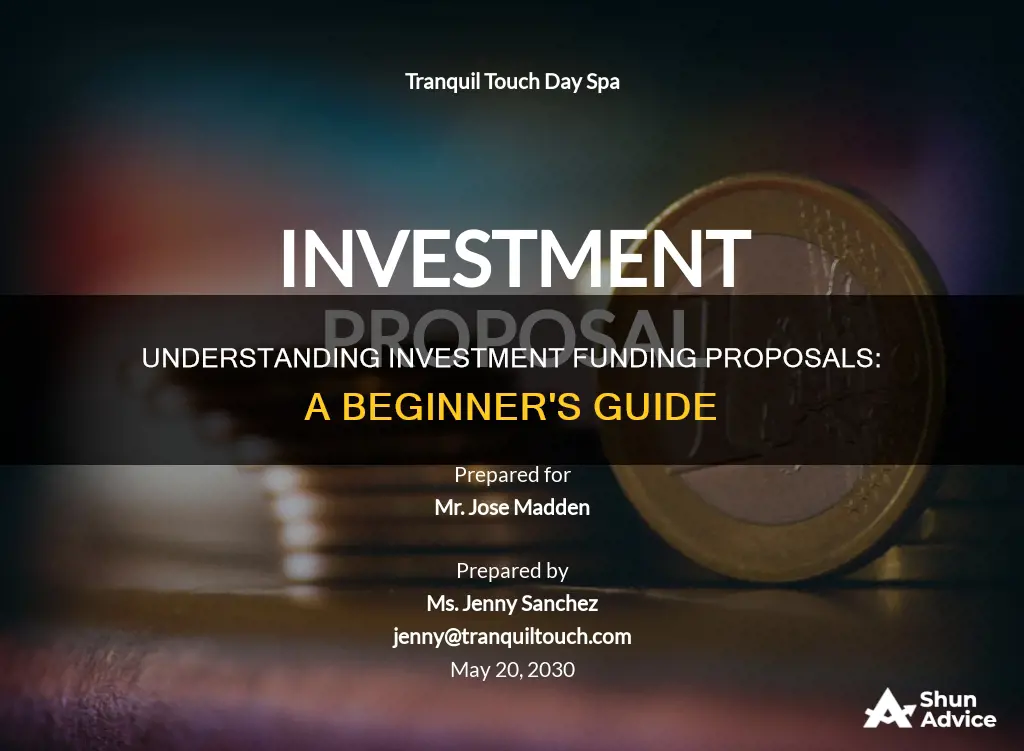
An investment funding proposal is a document or presentation that outlines a business plan and is used to attract investors and secure funding. It covers the business strategy, market analysis, financial projections, and potential returns to investors. The purpose of an investment proposal is to showcase the business's value, market potential, and financial viability, ultimately convincing investors to provide the necessary capital. This proposal is typically created when a startup has reached milestones that demonstrate its potential for growth and scaling.
| Characteristics | Values |
|---|---|
| Purpose | To raise capital |
| Audience | Potential investors |
| Focus | Business and potential returns for the investor |
| Content | Company financial details, market opportunities, competitive advantages, and financial projections |
| Format | Text document, PDF, or presentation |
| Length | Concise, not too long |
| Tone | Formal, clear, concise, objective |
| Structure | Cover letter, executive summary, statement of need, objectives, methods and strategies, evaluation plan, budget, sustainability plan, organisational information, signature |
What You'll Learn

Executive Summary
Business Name: [Your Company Name]
Location: [Company Location]
Business Description: A brief description of the business or project.
Funding Required: [Amount of Funding Needed]
Purpose of Funds: A brief description of what the funds will be used for.
Summary of Financial Projections: Highlight the key financial metrics and expected returns for investors.
Keep this section concise and direct. Investors often review many proposals in a short time, so write a compelling and informative executive summary that is easy to navigate.
Business Overview: A detailed description of the business or project.
Mission Statement: [Your Mission Statement]
Business History: A brief history, including key milestones.
Objectives: Short-term and long-term business goals.
Emphasise the business history if your business has experienced milestones that might be convincing to investors. Otherwise, draw attention to your business's project description and its goals.
Industry Overview: A description of the industry and its trends.
Target Market: A detailed analysis of the target market and customer demographics.
Market Needs: Explain the market need your business addresses.
Competitive Analysis: An analysis of competitors, their strengths and weaknesses, and your competitive advantage.
Whenever possible, use visual aids to explain the nature of the market and competitive analysis. Visual aids aid comprehension and can help make a strong case for your organisation.
Products or Services: A detailed description of the products or services offered.
Unique Selling Proposition (USP): What makes your product or service unique?
Development Stage: The current stage of development and any future plans.
When discussing future plans, be sure to use concrete details. Include timelines and specifics regarding price, manufacturing, and product type.
Marketing and Sales Strategy: Describe your approach to marketing and sales. Depending on your business stage, you may already have some marketing and sales strategies in place. If you're an early-stage organisation, discuss your plans to grow in these areas. Discuss sales strategy for revenue creation, as well as distribution channels, advertising, and content channels.
Management and Organisation: Information about key team members and their roles.
Organizational Structure: The company's organisational chart.
Advisors and Consultants: Information about any external advisors or consultants.
For investors, the marketing team details are important—especially for early-stage investors who don't have a significant history to draw upon. Be sure to frame management team achievements to foster trust.
Operational Plan: Talk about production processes and logistics. This could include manufacturing plans, facility locations, and anything else related to the execution of your product or service.
Financial Plan: Speak to specifics regarding financial projections and your business's historical performance: income statement, cash flow statements, and balance sheets. Perform a break-even analysis and provide a projection of return on investment.
This part also outlines funding requirements, the use of funds, and an exit strategy for investors. This section should be well-resourced to bolster the proposal.
Risk Assessment: Provide an assessment of potential risks and obstacles your organisation will face as it grows. Provide solutions to those risks to demonstrate you have a plan if those obstacles arise. You can also include contingency plans, playing out different potential scenarios.
Appendix: Include legal agreements, research reports, patents, resumes, and any other piece of information you find relevant and compelling for your investor.
Invest in Index Funds with a Roth IRA
You may want to see also

Business Description
This section of the investment proposal breaks down what your business is, describing its function, a quick overview of the products or services, and some background information. You may also choose to include a mission statement or an overview of the business's goals.
For example, if you are writing an investment proposal for a company that produces and sells widgets, you would explain the function of widgets, the different types of widgets the company produces, and the history of the company.
You should also include an overview of the industry and its trends, as well as a detailed analysis of the target market and customer demographics. This will help investors understand the market need that your business addresses.
It is also important to include a competitive analysis in this section. Identify your major competitors and explain your approach to positioning and differentiation. This will demonstrate that you have a strong understanding of the market and your competitors, and that you have a well-thought-out strategy for success.
If your business has experienced any significant milestones or has a particularly compelling history, be sure to emphasize this in the business description. This can help to build a convincing case for your investor.
Overall, the business description section of your investment proposal should provide a comprehensive overview of your business, its function, its products or services, and its position in the market. This will help investors understand the context and potential of your business, making it more likely that they will be interested in providing funding.
Oppenheimer Funds: Puerto Rico Debt Investment Status
You may want to see also

Marketing & Sales Strategy
The marketing and sales strategy section of your investment proposal is where you will discuss your approach to marketing and sales. Depending on the maturity of your business, you may already have some marketing and sales strategies in place. If you are an early-stage organisation, you will discuss your plans to grow in these areas.
Discuss your sales strategy for revenue creation, as well as distribution channels, advertising, and content channels. If you are an existing company, include a business description and provide historical and current financial data. If you are a new business, share information about products you have been involved in and made a significant contribution to.
Your marketing plan should include strategies for promoting your product or service. Outline your sales tactics and channels, pricing strategy, and distribution plan. Provide evidence that your marketing strategies, sales tactics, and pricing models are based on facts. Give data whenever possible to demonstrate that your approach is the strongest strategy.
Remember to keep it concise and focused on financial details and potential returns to capture investor interest. Avoid unnecessary complexity and irrelevant information.
Safe Investment Havens: Secure Funds for Peace of Mind
You may want to see also

Management/Organisation
Management/Organization
The management and organization section of an investment proposal is crucial as it provides investors with information about the people who will be executing the business plan and the structure of the team. This section should include:
- Management Team: Provide an overview of the key team members and their roles within the company. Highlight their skills, experience, and achievements relevant to the project. Investors will be interested in the qualifications and expertise of the management team to assess their ability to lead the company successfully.
- Organizational Structure: Present the company's organizational chart, showing the hierarchy and reporting structure. This visual representation helps investors understand the reporting lines, decision-making processes, and overall functioning of the organization.
- Advisors and Consultants: If your company has external advisors or consultants, this is the place to mention them. Include their backgrounds and areas of expertise, and how they contribute to the business. External advisors with relevant industry experience can add credibility and value to your proposal.
- Operational Workflow: Give an overview of the day-to-day operations and how the team works together to achieve the company's goals. Describe the standard processes, communication channels, and collaboration strategies within the organization.
- Facilities and Equipment: Provide details about the physical locations of your business, including offices, manufacturing facilities, warehouses, or retail spaces. Additionally, mention any specialized equipment or technology your company utilizes to conduct its operations.
- Technology: Discuss any technology or software solutions that are integral to your business processes. This could include enterprise resource planning (ERP) systems, customer relationship management (CRM) software, or industry-specific tools that give your company a competitive edge.
- Production Plan: If your business involves manufacturing or production, outline the processes involved. Describe the steps from raw materials to finished products, including any unique or innovative techniques your company employs.
Remember to focus on providing a clear picture of your management team's capabilities, the organizational structure that promotes efficient operations, and the resources available to execute the business plan. This section should instill confidence in investors that your company has the right people, structure, and resources in place to achieve its objectives.
Hedge Funds: Registered Investment Companies or Not?
You may want to see also

Operational Plan
The operational plan is a crucial section of your investment funding proposal, detailing the inner workings of your business and how you will deliver your product or service. It covers the following:
Production Processes and Logistics
Describe your production processes and the logistics involved in delivering your product or service. This includes manufacturing plans, facility locations, and any other relevant details.
Day-to-Day Operations
Outline the day-to-day operations of your business, including the operational workflow, facilities and equipment used, technology employed, and any specific production plans.
Staffing and Organisation
Provide an overview of your current team structure, including the number of employees, their roles, and the location of your business. If you plan to hire additional staff with the investment funding, include this information as well.
Operational Expenses
Detail any operational expenses, such as equipment, technology, or facility rental. Be thorough and include all relevant costs to ensure an accurate representation of your business's financial needs.
Scalability and Growth
Discuss your plans for scalability and growth. How will the investment funding enable you to expand your operations and increase your output? Outline the expected timeframe for growth and any milestones you aim to achieve.
Risk Assessment and Mitigation
Identify potential risks and challenges that may impact your operations, and outline strategies to mitigate these risks. Demonstrate your ability to navigate obstacles and ensure the smooth running of your business.
A Beginner's Guide to Index Funds on Webull
You may want to see also







